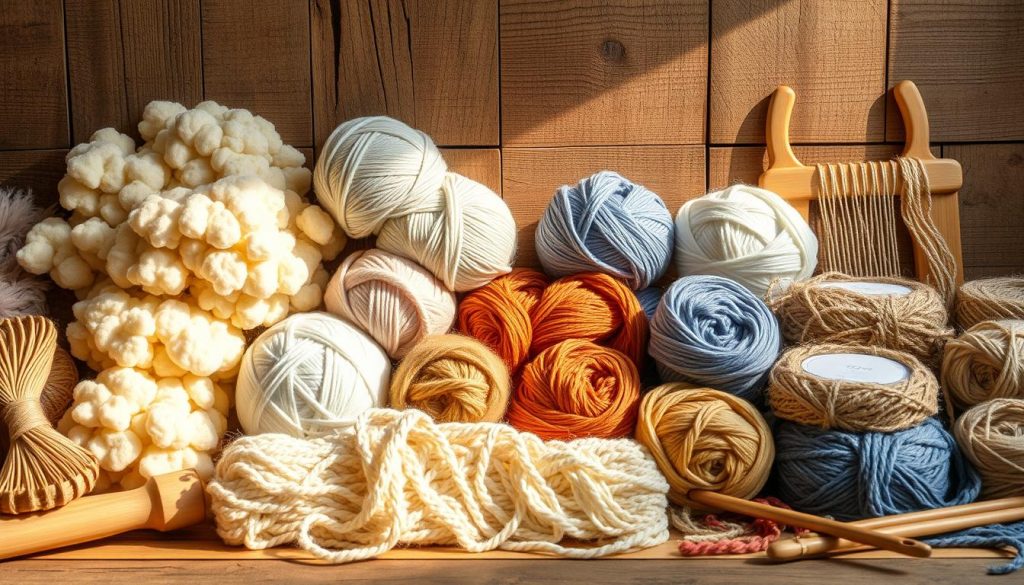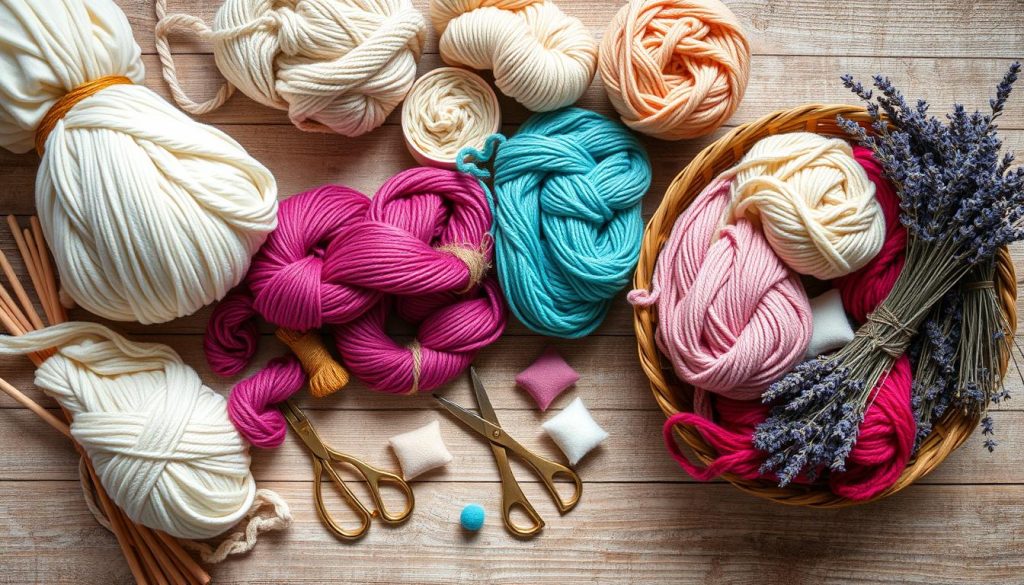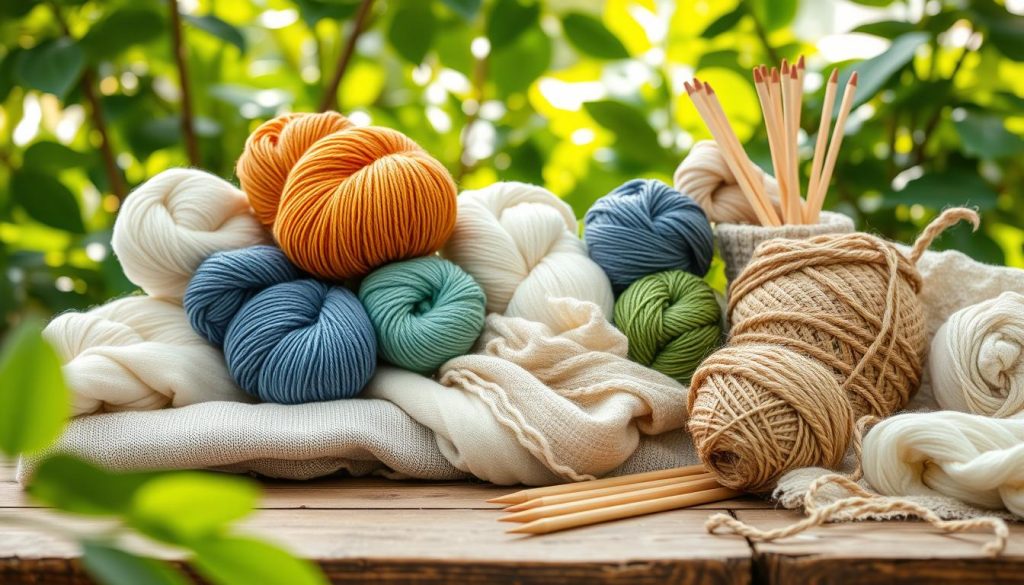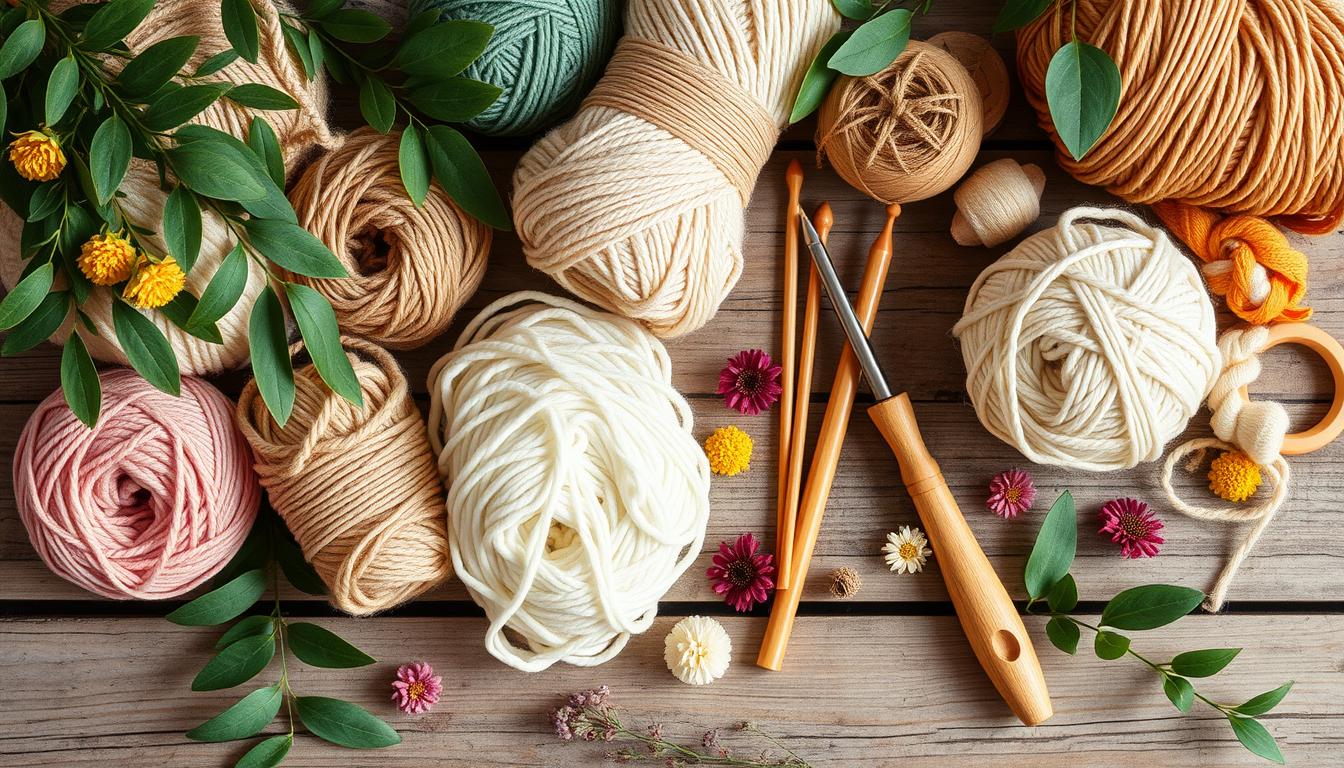I’m excited to share my favorite natural fiber crafting supplies with you. They’re perfect for beginners who want to explore sustainable crafting. I believe in using organic yarn and natural fiber supplies that are eco-friendly, durable, and versatile.
As a beginner, it’s key to start with the right materials. That’s why I recommend high-quality natural fiber crafting supplies. These include cotton and wool, which offer texture, warmth, and breathability.
I’ll help you choose the best materials for your projects. Whether you’re looking for organic yarn or other sustainable materials, I’ll give you tips and recommendations. This will help you start your crafting journey.
What Are Natural Fibers and Why Use Them?
Natural fibers have been key in crafting for centuries. They offer sustainability, durability, and beauty. As a crafter, I value eco-friendly supplies. They help us connect with nature and reduce our impact.
There’s a wide range of natural fibers like cotton, wool, hemp, and jute. Each has its own special qualities and uses.
Handmade supplies from natural fibers have many benefits. They are breathable and comfortable. Plus, they add a unique touch that synthetic materials can’t match. I believe in choosing craft supplies that are good for the environment and fair to makers.
- Cotton: a versatile and easy-to-work-with fiber perfect for beginners
- Wool: a warm and textured fiber ideal for knitting and crocheting
- Hemp: a durable and eco-friendly fiber great for making bags and home decor items
- Jute: a sturdy and breathable fiber often used for rugs and wall hangings
Choosing natural fibers and supporting ethical craft supplies is rewarding. We make beautiful pieces that bring us joy and help the planet. Whether you’re new or experienced, exploring natural fibers is a creative adventure.
Essential Tools for Working with Natural Fibers

Exploring natural fiber crafting, I’ve learned the value of the right tools. Eco-friendly materials like natural dye kits and biodegradable yarn are key. They make working with natural fibers easy and fun.
Having the right tools takes my projects from simple to stunning. Eco-friendly materials help me create unique, sustainable pieces. These pieces not only look great but also support the environment.
Basic Tools I Can’t Live Without
- Scissors: A good pair of scissors is essential for cutting natural fibers like cotton, wool, and hemp.
- Needles: A variety of needles in different sizes and types is necessary for sewing and weaving with natural fibers.
- Yarn needles: These are used specifically for knitting and crochet projects, and are designed to handle the thickness and texture of natural yarns.
Advanced Tools for More Complex Projects
For complex projects, I use tools like spinning wheels and looms. These tools help me create detailed patterns and textures. With natural dye kits and biodegradable yarn, I make unique, sustainable pieces that highlight natural fibers’ beauty.
| Tool | Description |
|---|---|
| Spinning wheel | Used to spin natural fibers into yarn |
| Loom | Used to weave natural fibers into fabric |
| Natural dye kits | Used to dye natural fibers with eco-friendly dyes |
The Best Natural Fiber Yarns for Beginners
Choosing the right yarn is key for beginners in natural fiber crafting. With many options, picking the best can be tough. Here, we’ll look at top natural fiber yarns for beginners, focusing on organic, sustainable, and eco-friendly choices.
There are several natural fiber yarns to consider. Cotton yarns are great for beginners because they’re versatile and easy to work with. They’re soft, durable, and work well for many projects like knitting, crochet, weaving, and tapestry. Wool yarns add warmth and texture, perfect for colder weather. Hemp yarn is also eco-friendly, known for its strength and sustainability.
Cotton Yarns: Versatile and Easy to Use
Cotton yarns are a favorite among beginners. They’re easy to use and versatile. You can find them in many colors and weights, fitting various projects. Choose organic cotton to avoid chemicals and pesticides.
Wool Yarns: Warmth and Texture
Wool yarns are great for beginners who want warm, textured projects. They come in different weights and colors, from lightweight to thick. When picking wool, look for sustainable and eco-friendly options.
Hemp Yarn: Eco-Friendly Choice
Hemp yarn is a sustainable choice for beginners. It’s strong, durable, and pest-resistant. Opt for certified organic and sustainably sourced hemp yarn.
| Yarn Type | Benefits | Drawbacks |
|---|---|---|
| Cotton | Soft, durable, versatile | May shrink or lose shape |
| Wool | Warm, textured, sustainable | May be itchy or expensive |
| Hemp | Strong, durable, eco-friendly | May be rough or expensive |
Crafting Techniques with Natural Fibers

I’m excited to share my knowledge of natural fiber crafting. We’ll explore knitting, crocheting, and weaving. These techniques help create unique, eco-friendly projects.
Choosing eco-friendly supplies is key. It reduces our environmental impact. We can make sustainable projects that are both beautiful and good for the planet. Techniques like knitting, crocheting, and weaving are popular for working with natural fibers.
- Knitting: a versatile technique that can be used to create a wide range of projects, from clothing to home decor
- Crocheting: a great technique for creating amigurumi toys, granny squares, and other home decor items
- Weaving: a technique that can be used to create beautiful and intricate designs, from simple tabby weave to complex tapestry weave
For beginners, online tutorials and workshops are great resources. They focus on handmade and eco-friendly supplies. Online communities, YouTube, and local craft stores offer valuable learning opportunities. By choosing sustainable supplies and techniques, we can make projects that are both beautiful and eco-friendly.
Let’s keep exploring natural fiber crafting together. Try different techniques and supplies. Always think about the environmental impact of our crafting. Together, we can build a sustainable crafting community that values eco-friendly supplies.
| Technique | Project Ideas | Skills Required |
|---|---|---|
| Knitting | Scarves, hats, sweaters | Basic knitting stitches, yarn management |
| Crocheting | Amigurumi toys, granny squares, blankets | Basic crocheting stitches, hook management |
| Weaving | Tapestry, wall hangings, baskets | Basic weaving techniques, loom management |
Must-Have Natural Fiber Fabrics
Choosing the right fabric is key in natural fiber crafting. I look for materials that are good for the planet and last long. Here, we’ll talk about three top picks: cotton, linen, and jute.
Cotton Fabric
Cotton is great for beginners because it’s easy to use and versatile. It has many benefits:
- Soft and breathable
- Absorbent and durable
- Eco-friendly and sustainable
Linen and Jute Fabrics
Linen and jute are also excellent choices. Linen is perfect for summer projects because it’s breathable. Jute works well for rustic designs. Here are their benefits:
- Natural texture and beauty
- Durable and long-lasting
- Sustainable and eco-friendly
Using natural fibers lets crafters make unique, eco-friendly projects. Whether you’re new or experienced, these supplies help you be creative and sustainable.
| Fabric Type | Benefits | Drawbacks |
|---|---|---|
| Cotton | Soft, breathable, durable | May shrink or lose shape |
| Linen | Breathable, natural texture, durable | May be prone to wrinkles |
| Jute | Natural texture, durable, eco-friendly | May be rough or scratchy |
Where to Buy Quality Natural Fiber Supplies

I’m always searching for the best places to find eco-friendly fiber arts supplies. I look for handmade and environmentally-friendly options. It’s important to me to support businesses that care about the planet.
Shopping locally is my go-to choice. It’s better for the environment and helps small businesses thrive. Local craft stores have everything from yarn to tools, all made from natural fibers.
Local Craft Stores to Visit
- Check online directories for local craft stores in your area
- Visit fiber festivals and craft fairs to discover new suppliers
- Join local crafting groups to connect with other crafters and learn about their favorite suppliers
Online Retailers I Trust
Online, I seek out stores that focus on sustainability and honesty. My top picks offer a variety of eco-friendly supplies. They have everything from handmade to environmentally-friendly options.
Shopping from local stores and trusted online retailers makes me happy. It shows I care about the planet. Whether you’re new or experienced, I hope you find the supplies you need to create something amazing.
My Favorite Brands for Natural Fiber Supplies
I love searching for brands that care about the planet as much as I do. When it comes to organic yarn and sustainable crafting materials, some brands really stand out.
Noteworthy Yarn Brands
My top yarn brands focus on organic and eco-friendly options. They use methods that are good for the environment. Here are a few favorites:
- Patagonia: Known for their environmental commitment, Patagonia offers organic yarn.
- Reynolds: This brand makes sustainable yarns from natural fibers like wool and cotton.
- Malabrigo: This Uruguayan brand has organic yarns in bright colors, all from sustainable materials.
Fabric Manufacturers I Love
I also love fabric manufacturers that care about the planet. They use sustainable materials and methods to make beautiful fabrics. Some of my favorites include:
- Nearsea Naturals: They offer organic cotton fabrics great for sewing and crafting.
- EcoCraft: Specializing in sustainable fabrics, EcoCraft has eco-friendly options for crafters and sewists.
Choosing brands that care about the planet helps us all. It reduces our impact and supports a sustainable crafting community.
Tips for Caring for Natural Fiber Crafts
As we finish our look at natural fiber crafting supplies, it’s key to know how to care for them. Natural fiber crafting supplies, like eco-friendly fiber arts supplies and biodegradable yarn, need a little extra care. But the benefits are worth it.
Washing and Maintenance Basics
When washing your natural fiber crafts, choose gentle, eco-friendly detergents. Avoid harsh chemicals. Hand washing is best, as it prevents damage to the fibers.
If you must machine wash, use the delicate cycle and cool water. This helps prevent shrinkage and damage.
Storing Natural Fiber Supplies Safely
Proper storage is crucial for keeping your natural fiber crafting supplies in great shape. Store yarn and fabrics in a cool, dry place, away from sunlight. Sunlight can cause fading and damage.
Use airtight containers or breathable fabric bags to protect against moths and other pests.
By following these simple tips, your eco-friendly fiber arts supplies and biodegradable yarn projects will stay beautiful and durable for years. Enjoy the natural beauty of fiber crafting and let your creations shine!

